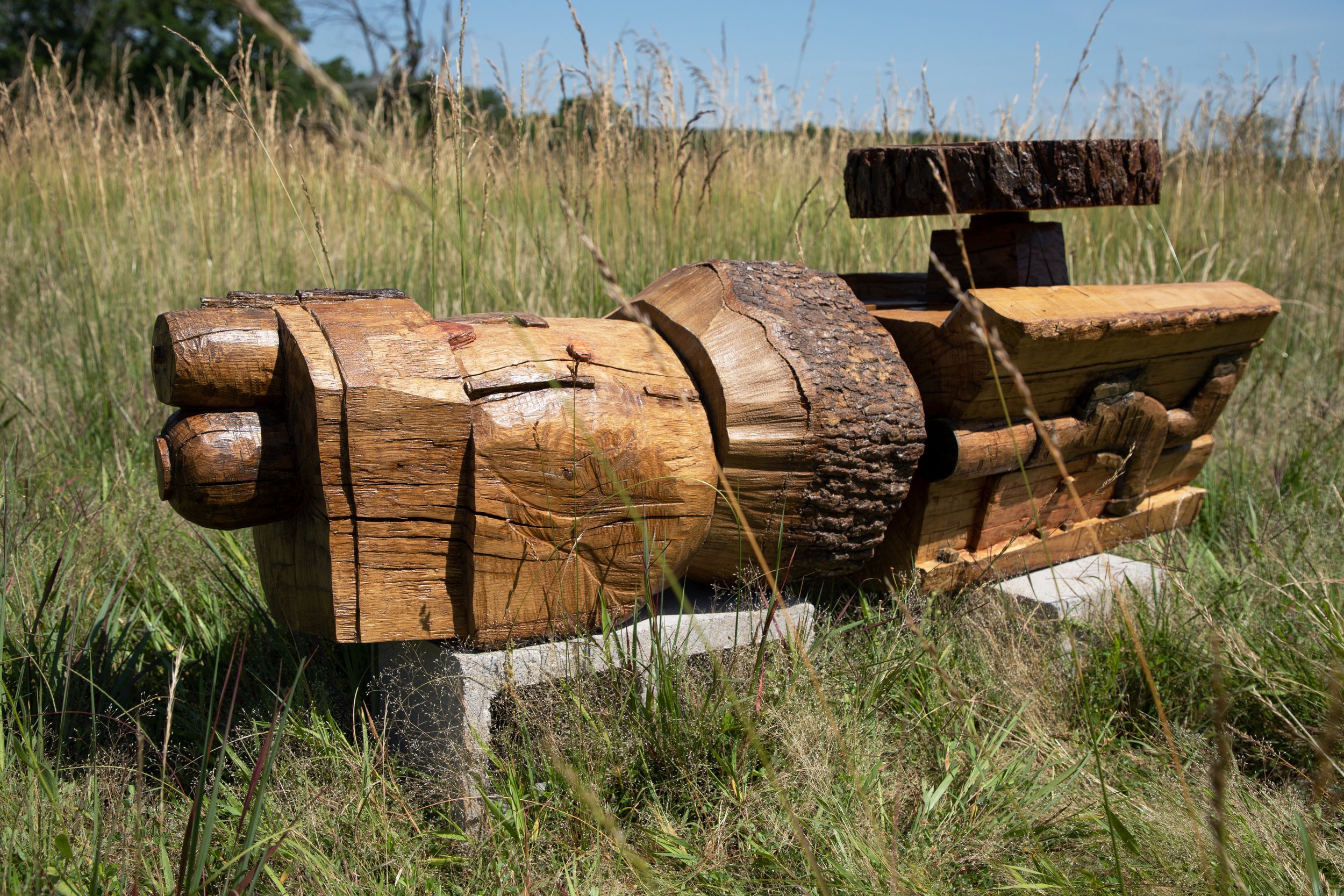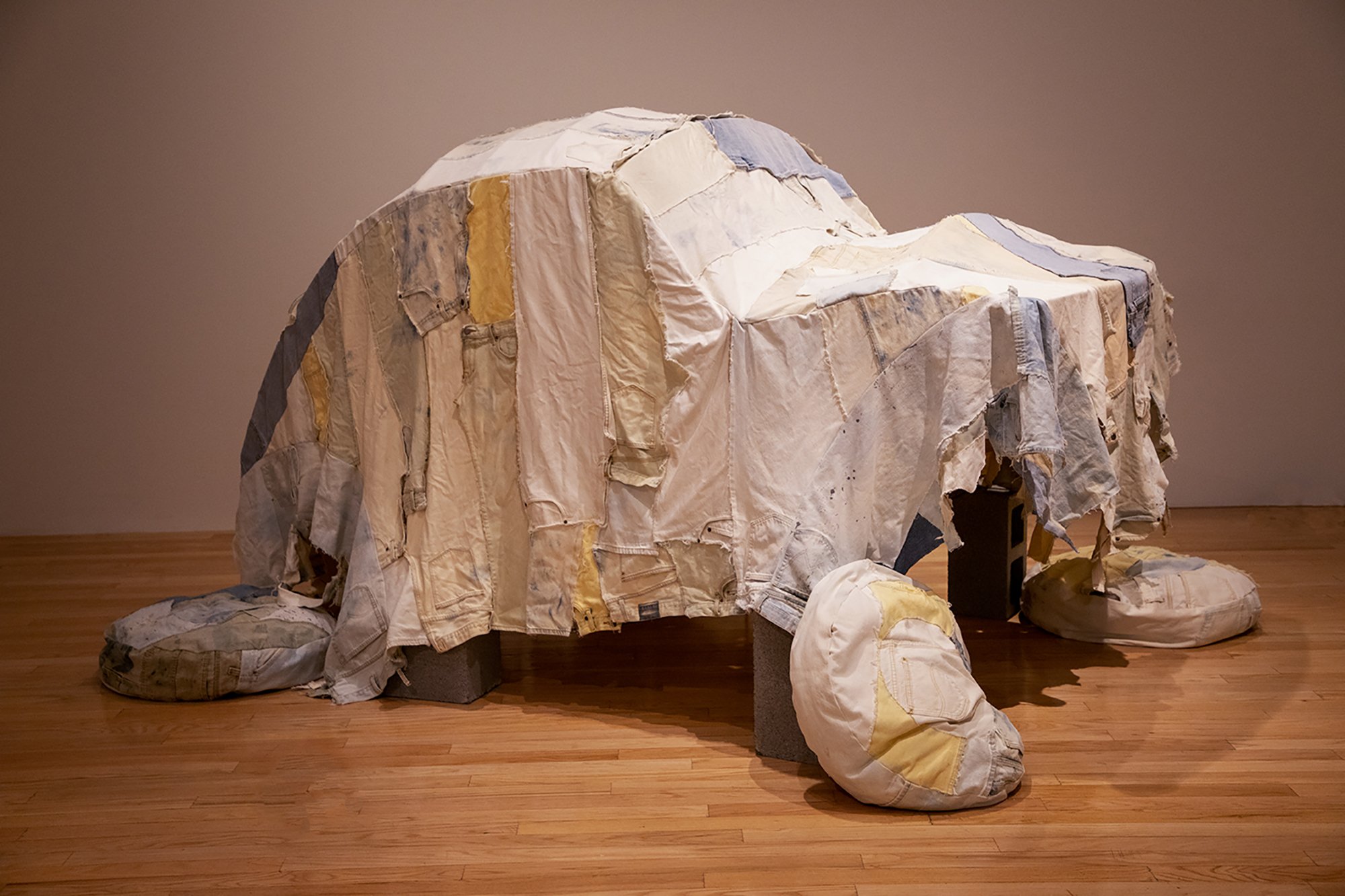Thesis: Turn over the engine!
MFA Thesis Project: Turn over the engine!
When contemplating the life of my late father, I imagine myself in an auto salvage yard sifting through the wrecked or totaled cars he used to drive, probing them for traces of him. After my father died in a car accident, as his sole beneficiary, I inherited everything he had, including a classic car that does not run. Within an artist book, I am chronicling my pursuit of my father through these items and the cars that he travelled in. With myself as the narrator, I am retelling his story while recounting the cross-continental road trip I embarked on to the multiple places he lived throughout his life. Along with this project, I am sculpting flawed effigies of components from his vehicles. I use materials reminiscent of labor and craft, like sewn blue jeans and carved wood, to explore the deep complexity of existence because, like automobiles, there are multiple parts that contribute to functionality.
Throughout his life, the cars my father drove symbolized pivotal moments that altered his path. They have become the vessels through which I have tried to understand him – not just as my father but as a person containing multiple facets of human character, both good and bad. Within the life of my dad, there was a roughhewn vernacular that spoke of blue-collar labor, crisis, loss, and individuality. These aspects relate to the craft of car restoration and rural human geography in a world that is increasingly losing its accessibility to tactile pursuits due to advances in technology. Because my drive to understand my father is now interwoven in his own narrative, larger questions are raised in my work regarding how we relate to one another, how we exist in the world, what inheritance means, and what happens to memory.
Artist book
An artist book became the natural culmination for my project. In my other projects, I have somewhat distanced myself from my father to instead explore macro topics adjacent to him, like blue collar labor, rural existentialism, the function of ossuaries, folklore, and handcraft as it relates to modernity. However, in an artist book, intimacy is inevitable. The two artist books that affected and guided me in my work were Larry Sultan’s Pictures from Home and Ben Schonberger’s Beautiful Pig. In both, the artists looked deeply into people and evaluated their own relationship to them. As with Sultan’s book, I source images not only from my own photography, but also include film stills from family movies and archived photo albums. I use these as a means of deciphering the past and recontextualizing familial archetypes like the ill-fated quest of the “American Dream.” However, I also incorporate materials and objects, like police reports and handwritten letters, to relay narrative information similar to Schonberger’s approach in order to attempt to build a foundation for the histories encoded within the archive. One major difference between my projects and the artists mentioned is collaboration: they had active working relationships with the people they were representing, but my father is a passive partner.
In my artist book, titled Turn over the engine!, I weave the experience of my father’s death with a roughly chronological account of his life. My goal is to present my father as part of the contemporary folklore canon. Folklore has an adaptive nature that continuously absorbs, and it becomes a record through which people acknowledge change, map human geographies, and grapple with ideologies. I am using folklore as a tool to subvert what history chooses to record. Keith, my dad, would have been viewed as a crude character in today’s society, deemed minute and reduced to a simple typecast. However, by investigating his archive, tracking his human geography, and interviewing those closest to him, I found my father to embody ontological and existential questions regarding the state of being and choice. For example, I found documentation of several attempts he had made to commit to a group or belief, like Alcoholics Anonymous and church groups, but he always chose to leave at a certain point, abandoning the effort.
The vehicles surrounding his life act as a conduit and guide in the book, illustrating the pivotal moments that shaped his identity while also representing his failings, like the many DUIs he received and the classic Chevelle he toted around for thirty years but never gathered the courage to restore. My account and posthumous perspective of him is the skewed lens through which the book is presented. As I drive on the road trip, chasing the remnants of his past, my attempts to understand through my grief and self-reflection are revealed, hovering over the unfolding narratives and creating many false starts like an engine trying to catch.
Sculptures
“An ossuary is a container where the dead are kept, not buried, not forgotten. Vintage cars, derelict and gently rusting, pepper the pastures and yards of rural America. These cars, while not preserved or renovated, have been given a place to rest, to be seen, to be remembered.”
After looking through my dad’s belongings and establishing a record of all the vehicles in his life, I began to compare existentialism and human choice to my findings. In my first sculpture Reckon and Lament, I wanted to pay homage to a part of his life while also experimenting with the notion of an ossuary. To do this, I recreated the 1961 Volkswagen Beetle Keith received as a high school graduation present from his father. His own dad died the following year, and Keith drove the Beetle across the country to attend his funeral, where he buried a letter in his hand. When he returned home, my dad continued to put off changing the oil in the car until the engine seized, a symbolic climax to represent this loss. In my sculpture, I wanted to resurrect this car then use it express my own grief while exploring its usage as the vessel. My father wore durable blue jeans as part of his work uniform, so I constructed the exterior of the Beetle and three tires from bleached blue jeans sewn together that I then hung over a welded metal frame. The resulting sculpture resembles a ghostly shroud that is reminiscent of labor and a body.
After working on the representing the exterior of one of my father’s cars, I then delved into what the interior could represent. During my road trip, I read Zen and the Art of Motorcycle Maintenance by Robert M. Pirsig which relates motorcycle upkeep and the self-learning it requires with ideas on life and what to value. I began to research how cars work and the parts that make them operational, and I saw a correlation between human choice and the mechanics of a drivetrain that includes the parts that propel a vehicle in motion. Pre Covid-19, I started to make the rear-wheel drivetrain housed within the 1969 Chevelle that I inherited from my dad. Using wood and carving, I wanted to relate this sculpture to handcraft and the ways it has evolved. While woodworking is an antiquated craft, I argue that car restoration is its modern equivalent. Modern cars are no longer realistically accessible to us due to the advancements of technology; one would almost have to have a computer engineering background to work on a new car. By sculpting a drivetrain out of wood, I am raising concerns about a lack of self-reflection and self-reliance in an age where we turn too often to screens and media. Looking to Pirsig’s book, I am trying to place value on craft in order to attempt to understand what we prioritize and the choices that accompany those valuations.
Drivetrain: Motivation
Reckon and Lament
Conclusion
These three works coalesce to form the basis for demonstrating how my father, Keith, and his death are not only relevant and accessible but also representative of a blind spot in modern society. The topics I broach have become negated, because in the face of swelling urban sprawl and mutating technological advancements, crudities are viewed as an eyesore. However, beneath the dialects, regional hardships, family dynamics, and labor are the existential threads that ingrain people and communities together.







